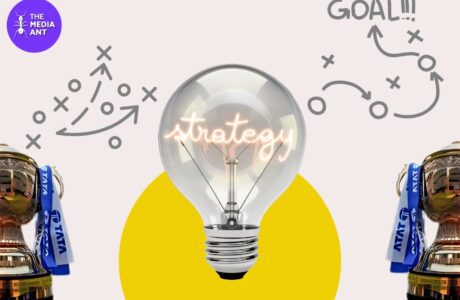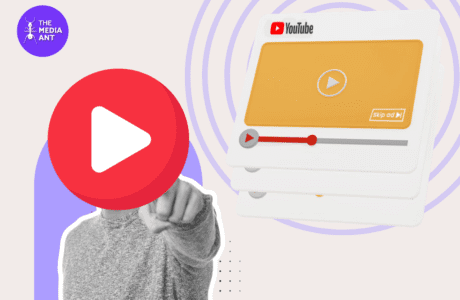What is “frequency” in the ad glossary?
Advertising frequency refers to the number of times an advertisement is presented to a target audience within a specific period. It is a crucial aspect of advertising strategy and plays a significant role in shaping consumer perceptions and behavior.
Frequency is essential for several reasons: Case Study Birds of Paradyes
Take into consideration the small, ammonia free, quirky hair colour product brand called “Birds of Paradyes” entering the market dominated by well-established competitors like, Loreal, Streaks and BBlunt.
Keeping in mind that Birds of Paradyes’ target market is millennials and GenZs which is why their 2 major platforms of advertising is Instagram and YouTube. The format of their ads generally include consumer testimonials and influencer marketing, along with images showcasing their newly launched products.
Here’s how the effectiveness of ad frequency apply to Birds of Paradyes’ advertising strategy:
- Reinforcing Brand and Message: Repeated exposure to an ad helps reinforce the brand’s identity and the key message it intends to convey. In a crowded marketplace, this reinforcement is vital to ensure that consumers remember and recognize the brand when making purchasing decisions.
Birds of Paradyes’ ad campaign emphasizes its commitment to easy DIY semi-permanent hair colour solutions. To stand out in a crowded marketplace, they have repeatedly shown their ads on Instagram to reinforce the brand’s identity as a vegan, cruelty-free, stylish hair colour choice.
- Building Awareness: Frequency aids in building brand awareness. People are more likely to remember and trust brands they have seen multiple times, which is particularly important for new or lesser-known brands entering the market.
As a new and lesser-known brand, Birds of Paradyes had to build brand awareness. Frequent ad exposure on Instagram ensured that potential customers come across the brand multiple times, which increased the likelihood of them remembering and trusting the brand when they think of easy to use, semi-permanent hair colour products.
- Aiding Recall: Higher ad frequency enhances brand recall. When consumers are exposed to an ad frequently, they are more likely to remember it when they need a product or service it promotes.
With higher ad frequency, people who’ve seen Birds of Paradyes’ ads are more likely to recall the brand when they need a variety of hair colour products. This recall can be critical when consumers are faced with choices in the store or online.
- Changing Behavior: For ads aimed at changing consumer behavior, such as encouraging a purchase or subscription, higher frequency is often necessary. It reminds consumers to take action and reinforces the benefits of doing so.
Birds of Paradyes’ goal is to encourage consumers to switch from conventional hair colouring products, ditch the salon and opt for DIY hair colouring products options. Higher ad frequency is essential to continually remind consumers about the benefits of using Birds of Paradyes, such as being a conditioner based, vegan, semi-permanent hair dyes which is available in a range of quirky colours .
- Overcoming Competition: In competitive industries, frequent advertising helps a brand stay top-of-mind. It prevents competitors from dominating the consumer’s attention.
In a market with well-established competitors, Birds of Paradyes needed to ensure its brand stayed top-of-mind. Frequent advertising helped the brand prevent competitors from dominating consumers’ attention and reinforced that they are a viable alternative.
In this example, advertising frequency played a pivotal role in helping “Birds of Paradyes” make its mark in a competitive market, build brand recognition, and influence consumer behavior by repeatedly emphasizing its unique selling points.
Key Points to Keep in Mind:
Factors influencing the determination of the ideal ad frequency include the advertising objectives, target audience characteristics, and the budget available. It’s crucial to strike a balance, as both underexposure and overexposure can have negative effects.
- Underexposure: Underexposure occurs when an ad is not shown frequently enough, which can lead to a lack of brand recognition and message retention. The audience may not fully grasp the intended message, and the ad’s impact may be minimal.
- Overexposure: Overexposure happens when an ad is shown too frequently, potentially leading to ad fatigue and annoyance. Consumers may become irritated by repetitive ads, and the message may lose its effectiveness.
In a digital age, advertisers have more tools and data to fine-tune their ad frequency. They can track ad performance and adjust frequency based on consumer interactions and responses. This dynamic approach allows for more effective and efficient advertising campaigns.
Advertising frequency is a critical component of advertising strategy. It helps build brand recognition, awareness, and trust while aiding in changing consumer behavior. Striking the right balance in ad frequency is essential for a successful advertising campaign.
How to determine the frequency of your ad campaign?
Determining the frequency of your ad and understanding the factors that affect it is crucial for creating an effective advertising campaign. Here’s how to do it:
Objective of your campaign: Awareness vs Trial
While deciding the frequency of your ad campaign you must decide the objective of your campaign;
- Are you looking to reach more audience?
- Are you looking to show your ad to a set audience several times?
The causal relationship between brand lift and frequency level. Through our analysis, we saw that lift for ad recall and purchase intent both increased with the frequency of exposure.
There the lift in ad recall slowed substantially after a frequency cap of 1 per week, the lift in purchase intent did not start to slow until close to a frequency cap of 1.5 per week. This result supports the hypothesis that higher frequencies are needed to impact greater behavior change, such as purchase intent.
I. Market Factors: Market factors are external conditions that impact businesses, including supply and demand, competition, consumer preferences, and economic conditions. These factors affect operations, profitability, and strategic decisions.
1. Brand Stage:
- Established Brand: This refers to a brand that has been in the market for a significant period and has already established a presence and recognition among consumers. Established brands like Maggi have a loyal customer base and a well-known product or service.
- New Brand: A new brand is one that has recently entered the market or is in the early stages of establishing itself. New brands, like Slurrp Farm, are often unknown to the majority of consumers and need to invest in advertising and promotion to create awareness and gain a foothold in the market.
Example:
Maggi (Established Brand)
Maggi, as an established brand, enjoys high brand recognition. It has been in the market for decades, and its name is synonymous with instant noodles. This widespread recognition means that consumers are already familiar with the brand, reducing the need for constant advertising.
Slurrp Farm (New Product)
Slurrp Farm, as a new product, faces the challenge of creating awareness from scratch. Most consumers have never heard of it, so the initial focus must be on introducing the product and building recognition.
The ad frequency for Maggi, an established brand, can be lower because of its strong brand recognition and existing customer base. For Slurrp Farm, a new product, higher ad frequency is essential to create awareness, compete for attention, educate consumers, and drive trial and adoption. The choice of ad frequency depends on the brand’s stage, objectives, and the competitive landscape in which it operates.
2. Market Share:
- High Market Share: This refers to brands that have a significant portion of the total market sales or revenue within their industry. High market share brands, like Amul in the dairy industry, are leaders and often have a strong competitive advantage.
- Low Market Share: Brands with low market share, such as Country Delight in the same industry, have a smaller piece of the market and may be facing more competition. They often need to work harder to increase their market presence.
Example:
Amul (High Market Share)
Amul is a well-established and dominant brand in the dairy industry. It has a high market share, and its name is synonymous with dairy products in many parts of India. This existing brand dominance means that consumers are already well-aware of Amul’s products.
Country Delight (Low Market Share)
Country Delight, as a brand with low market share, lacks the widespread recognition enjoyed by Amul. Many consumers might not even be aware of the brand’s existence. This lack of recognition necessitates increased advertising efforts to create awareness.
Amul, with its high market share and established presence, can have lower ad frequency because it focuses on maintaining its dominant position. In contrast, Country Delight, with lower market share, requires higher ad frequency to create awareness, compete for market share, educate consumers, and attract new customers. The choice of ad frequency is tailored to each brand’s market position, goals, and competitive dynamics.
3. Purchase Cycle:
- High Purchase Cycle: Some products or services have a longer purchase cycle, meaning consumers don’t buy them frequently. For example, automobiles fall into this category. People don’t purchase a new car often, so advertisers need to maintain brand awareness over a more extended period.
- Low Purchase Cycle: Other products have a shorter purchase cycle and are bought more frequently. Fast-moving consumer goods (FMCG) like groceries or toiletries are examples. Advertisers for these products often need to focus on staying top of mind, so consumers choose their brand when making a quick purchasing decision.
Example:
Automobile Brands (Long Purchase Cycle)
Automobiles are considered high-involvement and high-cost purchases. Consumers do not buy a new car frequently; it’s a significant decision that they make at intervals of several years. This infrequency in purchases means that there’s no urgent need for constant reminders through advertising.
FMCG Brands (Short Purchase Cycle)
FMCG products are daily or regularly consumed items, such as food, toiletries, or cleaning products. Consumers purchase these products frequently, often on a weekly or monthly basis. This high purchase frequency necessitates more frequent advertising to maintain brand presence and influence purchase decisions.
Automobile brands with longer purchase cycles can have lower ad frequency because they target consumers who don’t make frequent purchases and rely on thorough research. In contrast, FMCG brands with shorter purchase cycles need higher ad frequency to influence frequent purchasing decisions, remain competitive, and create top-of-mind awareness among consumers. The choice of ad frequency is tailored to each brand’s industry dynamics and consumer behavior.
4. Share of Voice (SOV):
- High SOV: Share of Voice refers to a brand’s presence in advertising relative to its competitors. High SOV brands, like H&M, have a strong and dominant presence in their advertising category. They may have a more significant share of the advertising space in their market.
- Low SOV: Low SOV brands are less prominent in their advertising category and may have to compete harder to gain consumer attention. They have a smaller share of the advertising space and may need to increase their advertising efforts to become more visible.
Example:
H&M (High Share of Voice)
H&M, with a high share of voice, is a dominant and well-recognized brand in the fashion industry. Its advertising is already prevalent and widely seen, creating a strong presence in the market. This established recognition means that consumers are already familiar with the brand.
Bonkers (Lower Share of Voice)
Bonkers, with a lower share of voice, may lack widespread recognition and brand awareness. Many consumers might not be aware of the brand or its products. This lack of recognition necessitates increased advertising efforts to create awareness.
H&M, with its high share of voice and established presence, can have lower ad frequency because it focuses on maintaining its dominant position and customer loyalty. In contrast, Bonkers, with lower share of voice, requires higher ad frequency to create awareness, compete for attention, educate consumers, and attract new customers. The choice of ad frequency is tailored to each brand’s market position, goals, and competitive dynamics in the fashion industry.
Understanding these factors is crucial for brands when developing their advertising and marketing strategies. It helps them tailor their approach to their specific market position, industry, and product characteristics.
II. Ad Factors: Ad factors refer to elements that influence advertising effectiveness, such as message complexity, uniqueness, campaign stage, and medium. These factors impact how ads are created and received by the audience.
1. Message Complexity:
- Low Message Complexity: Ads with low message complexity have straightforward, easy-to-understand messages. They typically aim to communicate a single, clear idea or benefit to the audience. These ads are often used for products or services with uncomplicated features or benefits. The goal is to make the message easily digestible and memorable for the audience.
- High Message Complexity: High message complexity ads involve conveying intricate information or multiple ideas. They might be used for products or services with many features or benefits that require detailed explanation. These ads can be informative and might target audiences looking for in-depth information before making a decision.
Example:
The above ad of Maggi has a simple and straightforward message, the narrative being that one can enjoy a packet of Maggi whenever they feel like as it takes 2 mins to cook. ‘2 Mins Noodles’ is the context that the ad focuses on in this ad, which is a simple message to put across and can have a lesser frequency.
The above ad by Maggi was released after the controversial ban of the noodles, and the narrative was quite different from their usual message. The brand took a shift from portraying their USPs like, 2 mins noodles, tasteful spices, etc to how much the consumers are missing their go-to snack. A message like this aims to tug at the hearts of the consumers and hence requires a higher frequency.
2. Message Uniqueness:
- High Message Uniqueness: Ads with high message uniqueness aim to stand out from the competition by highlighting distinctive features, benefits, or brand attributes. They often focus on what makes the product or service different from others in the market. These ads can create a strong brand identity and attract customers looking for something unique.
- Low Message Uniqueness: In contrast, low message uniqueness ads may focus on more common or universal features and benefits. They might aim to address basic consumer needs or desires without emphasizing what sets the brand apart. These ads can be effective when the product or service doesn’t have highly distinctive attributes.
Example:
The Nykaa Pink Sale ad is designed with a simple and direct message to make people aware of the sale. It does not require intricate or complex messaging to convey its purpose. The Pink Sale ad employs less frequency because it delivers a straightforward message about a limited-time sale, aiming to create a sense of urgency and optimize the allocation of advertising resources during the promotional event.
The Nykaa ad carries a powerful message of celebrating diversity and challenging conventional beauty standards. It goes beyond a simple sales promotion and aims to position the brand as a champion of inclusivity. The Nykaa ad promoting diversity and inclusivity aims at long-term brand positioning and changing perceptions, which often requires higher ad frequency. It’s about creating a lasting impact and reaching a wide audience with its meaningful message.
3. Campaign Stage:
- Existing Campaign: This refers to ads within a campaign that has been running for some time. Existing campaigns are often focused on maintaining brand awareness, reinforcing key messages, or retaining current customers. They may not need to introduce a new product or concept but rather build on what the audience already knows.
- New Campaign: New campaigns are launched when a brand is introducing a new product, service, or message. These ads need to create awareness and generate interest from scratch. They have the challenge of capturing the audience’s attention and making a strong first impression.
Example:
Sprite
The new campaign ‘Thand Rakh’ by Sprite released for World Cup 2023 needs higher ad frequency due to the lack of recognition, new messaging, and the freshness of the campaign. Conversely, an old campaign for Sprite ‘Seedhi Baat No Bakwas’ would not require higher ad frequency because it focuses on maintaining brand presence and reinforcing key messages to an already familiar and loyal customer base.
These ad factors play a significant role in shaping the content, style, and strategy of advertising campaigns. The choice between low or high message complexity, message uniqueness, and whether the campaign is new or existing depends on the brand’s objectives, target audience, and the competitive landscape.
III. Media Factors: Media factors encompass elements affecting advertising through channels, including seasonality, campaign duration, scheduling type, and media channels. These factors impact how and when ads are delivered to the audience.
1. Seasonality:
- Low Season: Low season in media factors refers to periods when consumer demand, engagement, or interest in a product or service is relatively consistent throughout the year. For example, products like basic household items or some types of technology may not have significant seasonal variations in demand.
- High Season: High season, on the other hand, corresponds to periods when there are noticeable fluctuations in consumer interest, often driven by specific seasons or events. For example, retailers experience the high season during the holiday shopping period, while beachwear brands have high seasons during the summer.
Example: Pantaloons
Festive seasons typically see a surge in consumer demand for clothing as people shop for new outfits for celebrations and gatherings. To capitalize on this increased demand, Pantaloons would want to ensure that its brand and products are top-of-mind for consumers. Higher ad frequency helps achieve this.
Advertising can be costly, and during periods of lower demand, brands often aim for cost efficiency. Pantaloons may reduce ad frequency to optimize its advertising budget.
Pantaloons increases ad frequency during the festive season to capitalize on higher demand, beat competition, influence consumer behavior, promote offers, and maintain a strong brand presence. During non-festive periods, ad frequency may be reduced for cost-efficiency, considering audience receptivity and inventory management.
2. Campaign Duration:
- Long Campaign Duration: Long campaign durations extend over an extended period, sometimes even year-round. They are suitable for brands with products or services that maintain a steady demand or need consistent brand reinforcement. Long campaigns are common for established brands.
- Short Campaign Duration: Short campaigns are limited to a specific timeframe, such as a few weeks or months. They are often used for time-sensitive promotions, product launches, or events. Short campaigns are designed to create a sense of urgency and maximize impact within a concentrated timeframe.
Example: Nykaa
Nykaa’s year-round general campaign typically requires less ad frequency compared to their Nykaa Hot Pink Sale, which is conducted over a shorter timeframe and demands higher ad frequency. The general campaign, spread throughout the year, aims to maintain a consistent brand presence and reinforce Nykaa’s identity in the beauty and cosmetics market. With its evergreen nature, this campaign targets a broad audience and doesn’t rely on frequent exposure.
In contrast, the Nykaa Hot Pink Sale is a time-sensitive event with the goal of creating immediate and heightened consumer engagement. To ensure that customers are well-informed about the sale, remember the dates, and participate, Nykaa needs to increase ad frequency during this period. This strategic move helps Nykaa retain a prominent place in consumers’ minds and prompts them to take advantage of the sale’s offers, creating a sense of urgency and excitement.
3. Scheduling Type:
- Continuous Scheduling: Continuous scheduling involves consistent and regular advertising throughout the year. It is a strategy used by brands that want to maintain a constant presence in the market and build brand awareness over time.
- Flighting: Flighting, also known as intermittent scheduling, involves alternating periods of heavy advertising with periods of no advertising. This approach is often used for seasonal products or to save costs during low-demand periods.
4. Media Channels:
- Multiple Media Channels: Using multiple media channels means employing a mix of advertising platforms, such as TV, radio, print, digital, and social media. This approach allows brands to reach a broader and diverse audience, leveraging the strengths of each channel.
- Single Media Channel: Focusing on a single media channel means concentrating advertising efforts on one platform, like TV or digital. This approach can be effective when the target audience predominantly engages with that specific channel or when budget constraints limit the use of multiple channels.
Example:
When a brand plans to choose multiple channels to run their ad campaign the frequency has to be less. This is because in case of multiple channels there are chances of your audiences overlapping which can lead to ad fatigue. Hence, keeping a lesser frequency will help in brand retention and higher purchase intent.
These media factors are essential for crafting effective advertising strategies that align with a brand’s objectives, target audience behavior, and the nature of the product or service being promoted. The choice between low or high season, campaign duration, scheduling type, and media channels depends on various factors, including market dynamics, competitive landscape, and budget considerations.
| Market Factors | Brand Stage | Established Brand | Brand Stage |
| Market share | High Market Share | Low Market Share | |
| Purchase cycle | Long Purchase Cycle | Short Purchase Cycle | |
| SOV | High Share of Voice | Low Share of Voice | |
| Ad Factors | Message Complexity | Low message complexity | High Message Complexity |
| Message Uniqueness | High Message Uniqueness | Low Message Uniqueness | |
| Campaign Stage | Existing Campaign | New Campaign | |
| Media Factors | Seasonality | Low Season | High Season |
| Duration | Long Campaign Duration | Short Campaign Duration | |
| Scheduling type | Continuous Scheduling | Flighting | |
| Media channels | Multiple Media Channels | Single Media | |
| Objective | Mark. Objective | Awareness | Trial |





